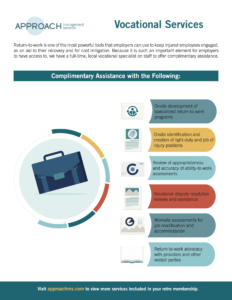
Vocational retraining, or simply Voc (rhymes with yolk), begins when the employer is unable or unwilling to offer permanent work within the injured worker’s physical restrictions. The worker meets with a vocational consultant who reviews their work history, educational experience and job restrictions in order to see what type of work the worker may be able to do. The worker then enters a training or college program to attain the skills to perform the job.
Voc can be good for motivated workers, but it’s usually not a successful program. If the employee isn’t excited by the new job, training can just be “going through the motions” and they may not be able to find work afterward. Meanwhile, the claim continues to rack up time-loss and training costs.

Costs of vocational retraining
Letting a claim go to voc can have a huge impact on your business. Voc claims are usually very expensive, which means your workers’ comp rates will increase for 4-5 years. And we’re talking big increases; up to 25% per year. Put simply, it’s enough to cause rates for a small business to nearly double in 3 years. Can you survive paying twice as much as your competition?
Retro refunds will also be impacted. Your company will earn little to no refund for the year. Voc claims are so expensive that they can put a big dent in the overall retro group, which means other companies in your association will also take a hit.
On top of that, you’re down a worker, so you’ll need to find money to hire a new employee. The Society for Human Resource Management calculated hiring costs in 2016 and found that the nationwide average is $4,425 for each position. It’s not hard to imagine it’s a lot more in our overheated job market. Plus, that new worker might not meet expectations.
Savings with returning to work
Add all of those costs together and you can see why we’re so big on helping your injured worker get back to work! When your employee returns to work, time-loss payments stop and there’s no need for retraining. It saves you money and takes away a lot of uncertainty for the worker.
It will take time and effort on your part, plus possibly an investment in new tools or equipment. But, lots of help is available to meet these challenges:
- As an Approach client, your Retro Coordinator will help to identify a new job and get the paperwork taken care of.
- Then, our Approach Stay-at-Work Specialist will help you claim refunds that are available from Washington state.
- Your company can earn $10,000 or more in reimbursements for salary, tools, and equipment when bringing an employee back to modified work — either on a short-term or permanent basis.
Best of all, your valued employee is back on the job, instead of off-work, facing an uncertain future while claims costs continue to rise. Return to Work is an aid to recovery, provides clarity for everyone and keeps your workers’ comp costs as low as possible.
